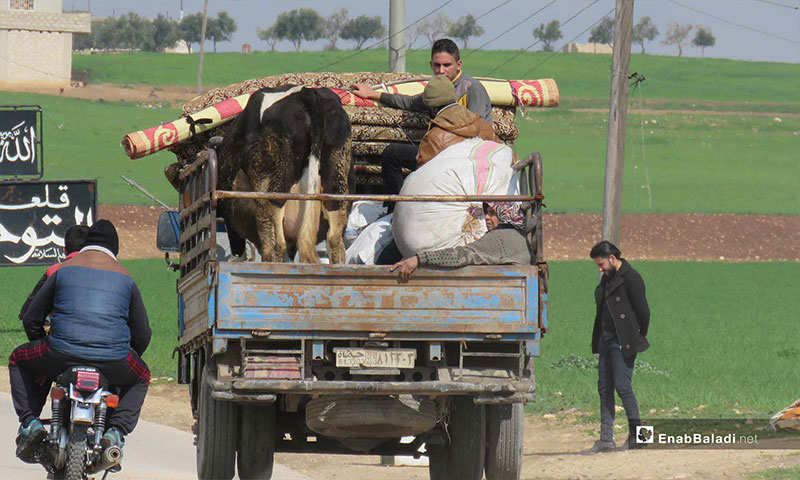Fleeing the daily shelling which escalated in rural Hama since the 12th of February, numerous families were forced to abandon their houses, displaced under dire humanitarian conditions.
While a patch headed towards Northern Syria, seeking a safe refuge, other dozens of families chose to move to the surrounding of the Turkish observation point in the village of Shair al-Maghar, western rural Hama, for several reasons.
These families cannot afford to rent houses away from the regions’ being shelled or even take refuge at the camps, in addition to preferring to stay close to their lands and villages.
Arnah al-Hassan, a woman displaced from the village of al-Huwayz, narrated to Enab Baladi the details of her and her family’s journey of displacement to the village of Shair al-Maghar, under the cold weather and the lacking humanitarian aid.
She said that the tent where they are living cannot help them deter severe cold, for they are short on blankets and all that can protect them from the hostility of winter, not to mention the children’s suffering due to starvation and absence of food-related materials.
The extensive bombardment of their village coerced them to abandon their it at night to the village of Shair al-Maghar, for they cannot afford the transportation fee to the camps in Northern Syria and they are unable to head towards the cities and towns in southern rural Idlib, for house rents are soring there.
Hussein al-Hashem, a man displaced from the village of al-Sharia, recounted to Enab Baladi the details of the ongoing shelling with which Assad’s forces are targeting the villages in western rural Aleppo, especially the southern part of al-Ghab Plain, starting from the city of Qalaat al-Madiq, which endured the largest share of the artillery and missile shelling, as far as the villages of al-Tuwayni, al-Sharia, al-Jasmeh, al-Huwayz, al-Huriyeh and Jiser Bait al-Rass.
The ongoing shelling forced the people to leave their houses in search for a safe shelter, commenting on which, Hussein said that the majority of these villages’ people belong to the poor class, which cannot afford renting houses in safe regions, who are thus forced to live in the open air in worn-out tents or stay in their cars and vehicles, while dozens of families settled in the mosques, given the small area of the Shair al-Maghar’s village and the adjacent ones in the Shashabo Mountain and their inability to accommodate the displaced people.
Calls For Stopping The Shelling
On his turn, Samer Satouf, a member of the Free Hama Provincial Council, told Enab Baladi that since the Sochi deal was concluded between Russia, Turkey and Iran, which clearly defines the de-escalation areas, a massive number of rural Hama’s people returned to their villages, to find themselves once again forced to leave them due to the regime’s brutal campaign, initiated against the cities and the towns of rural Hama, particularly the villages of the al-Ghab Plain, where the average number of shells that have been dropped on them is 50 shells a day.
Satouf pointed out that the extensive shelling has led to casualties and injuries among civilians mostly women and children, in addition to the displacement of more than 90% of the people.
He explained that the displaced people mostly headed to the camps and the nearby areas that are not being shelled, such as Shair al-Maghar village in the Shashabo Mountain, where the Turkish observation point is located.
He added that the local councils have appealed to the Turks, being guarantors of the pacification, demanding that they condemn the shelling, but the answer is late and the shelling continues, despite their former promises that they will be taking action to stop the shelling.
Dead And Injured Civilians
Ahmad Nairouzi, Director of the Western Sector of the Civil Defense, said that the violent shelling campaign undertaken by Assad’s forces against al-Ghab Plain, which started on February 12, is yet ongoing and has so far caused the death of a young man from the Qalaat al-Madiq, two little girls from the village of al-Tuwayni, two young men from the village of al-Sharia, in addition to the injury of 13 other civilians, most of whom are children and women.
He added that the displacement ratios from the cities and towns of rural Hama are estimated as thus:
| From Qalaat al-Madiq, 70%, from al-Sharia village, 50%, from the al-Huriyeh in al-Huwayz, 80%, and an additional 50% from the village of Al-Tuwayni. |

